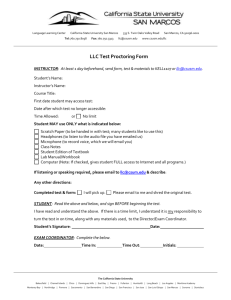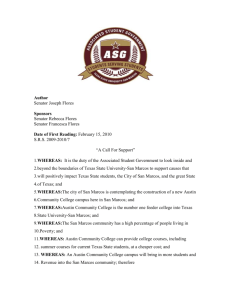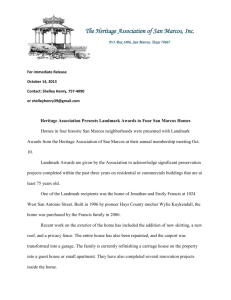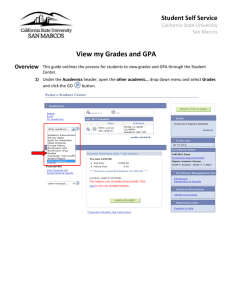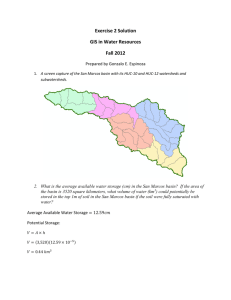CurranSanMarcos
advertisement
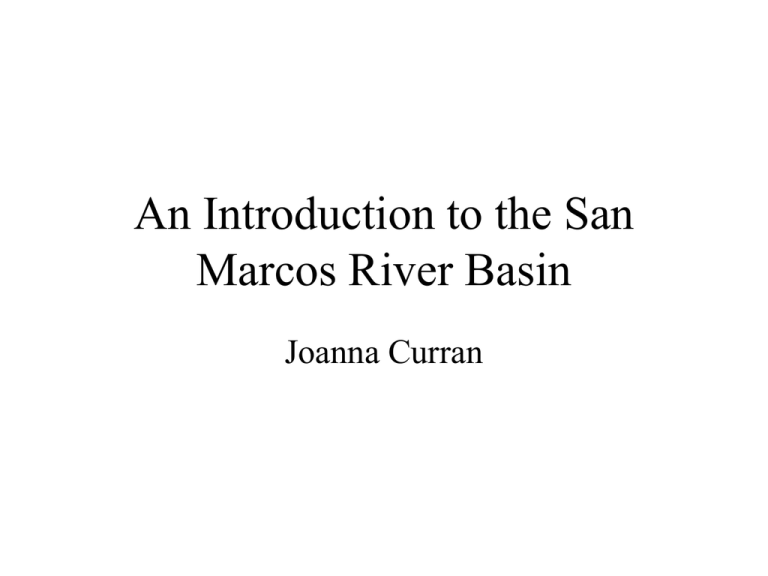
An Introduction to the San Marcos River Basin Joanna Curran San Marcos – not considered a large watershed contained within the Guadalupe Watershed which is a subwatershed of the Texas Gulf San Marcos Basin Texas State University Background Information • Climate type is Humid Subtropical: hot summers and mild winters • During tropical storm season this area experiences periods of heavy rainfall and short term flooding • Average annual temperature is 69 F • Average annual rainfall is 35.74 inches • Prevailing winds dominate from the Southeast History of Spring Lake • An earthen dam constructed in 1849 by Gen. Burleson just below the headwaters of the San Marcos River formed Spring Lake. 1901 postcard of Spring Lake Underwater Mermaid with Ralph, the Swimming Pig Some springs were only partially capped during operation by the Amusement Park Glass Bottom Boat Rides Comal and San Marcos Springs are the major outflow points for the Edwards Aquifer For legal consideration, the flow at San Marcos Springs is tied to the level of the J-17 well Size - Average of one inch Fountain Darter long • Description - Reddish brown; It displays a series of dark, horizontal, stitch-like lines along its sides and three dark spots at the base of the tail. Dark bars appear below, behind, and in front of the eyes. • Habitat - The fountain darter prefers clear, quiet backwaters with a profuse bottom growth of aquatic plants and matted algae. It is found in the Comal River and San Marcos rivers. San Marcos Gambusia Description - Had dark edges on dorsal and caudal fins, distinctly cross-hatched side, and was the only Gambusia species with lemon yellow median fins. Range - This species was restricted to a limited portion of the San Marcos River spring run a few kilometers below the headsprings. It always has been rare, and its existence difficult to document. Remarks - San Marcos gambusia were captured alive in 1979 and 1980. Despite considerable efforts to secure this species since then, none has been taken. Texas Blind Salamander Size - 3 1/4 to 5 3/8 inches Description - This salamander is a ghostly white to pink, with an iridescent appearance. The skin is translucent, and the larger organs are visible through the sides and belly. The head is large, with a strongly flattened snout and small black dots representing vestigial eyes under the skin. The body is slender, and the tail is about the same length as the head and body, tapering at the tip. Range - Found in the Balcones Escarpment of the Edwards Plateau, mostly underneath the city of San Marcos. Habitat: It lives in the perpetual darkness of underground streams and caves in the Purgatory Creek system. It is seen above ground only when pumping or the natural outflowing of the underground waters brings it to the surface. Texas Wild-Rice Size - 3 to 7 ft. long Habit - Aquatic perennial, below surface in swift water with only flowering stalk above, or upper stems and leaves above surface in slow water; stems rooting at joints. Leaves - Linear, elongate, green, to 45 in. long, 1/4 to 1 in. wide. Longitudinal survey of surface sediment into basic size fractions – most of the surface was visible Longitudinal survey of dominant vegetation in the river – secondary vegetation was also mapped Surface sediment, vegetation, flow data, water quality data, and endangered species sampling data are combined to identify separate habitat types Habitat 1 2 3 4 5 6 7 8 9 10 11 12 13 14 15 16 17 18 19 20 21 22 23 24 25 26 27 Vegetation 1 Caboamba Hydrilla None Potamogeton Potamogeton Potamogeton Hydrilla Potamogeton Potamogeton Wild Rice Wild Rice Hydrilla Hydrilla None Hydrilla Hydrilla Hydrilla Hydrilla Hydrilla Hydrilla Hydrilla None None Hydrilla Hydrilla None Elephant Ear Vegetation 2 Microphyllia Sagitaria None Ludwigia Hydrilla Wild Rice None Sagitaria Hyacinth None Ludwigia Wild Rice Wild Rice None Wild Rice Wild Rice Potamogeton Wild Rice Elephant Ear Potamogeton Potamogeton None None Wild Rice Wild Rice None None Vegetation 3 Elephant Ear Caboamba None Elephant Ear None Elephant Ear None None None None Sagitaria Elephant Ear Elephant Ear None None None Elephant Ear Elephant Ear None Sagitaria Sagitaria None None Potamogeton Elephant Ear None None Substrate 1 Mud Mud Cobbles Large Gravel Gravels Gravels Mud Gravels Gravels Gravels Mud Mud Gravels Cobbles Large Gravel Gravels Mud Med. Gravel Small Gravel Gravels Gravels Mud Mud Gravels Large Gravels Mud Mud Substrate 2 None None Large Gravel Med. Gravel Sand Sand None Sand Sand Sand None Small Gravel Sand Large Gravel Med. Gravel Sand None Sand Sand Sand Sand None Small Gravel Sand Med. Gravel Small Gravel Small Gravel Flow Type Backwater Pool Slow Run Pool (Springs) Riffle Fast Run Fast Run Pool Fast Run Fast Run Run Very Slow Run Slow Run Slow Run Plunge Pool Deep Pool Run Slow Run Fast Run Run Run Slow Run Slow Run Fast Run Run Run Slow Run Slow Run % Veg. Cover 100 100 0 30 50 50 100 60 30 80 80 100 50 0 100 15 100 30 20 80 90 0 0 80 80 0 5 Moving forward from 1993 to present Instead of looking at only the river, a watershed approach is used to study the San Marcos Modeling tools are available USGS Stream Gaging Stations 922 km2 922 km2 1071 km2 1071 km2 290 km2 290 km2 125 km2 125 km2 2178 km2 2178 km2 An Evaluation of Spring Flows to Support the Upper San Marcos River Spring Ecosystem Texas Parks and Wildlife Report published in 2001 Used RHABSIM: Riverine Habitat Simulation Model to identify the percentage of the San Marcos River that would be suitable habitat for the endangered species under different flow scenario Measured at cross-sections along the channel length for input to the hydraulic model 1996 study grew Texas Wild Rice in controlled conditions with the goal of finding the preferred substrate for growth Three sediment types were selected : 1) a moderately fine sediment from Sewell Park in the San Marcos River 2) a coarse sediment from the confluence of Sessom Creek and the San Marcos River 3) a very fine soil adjacent to the San Marcos River high root to shoot ratio of plants grown in clay which had intermediate nutrient concentrations; and, low productivity by plants grown in gravel and clay suggest that soil texture as well as nutrient concentration play an important role in Texas wildrice growth. Paula Power: Journal of Aquatic Plant Management, 1996 The San Marcos River Rangers - Measure Temperature, Dissolved Oxygen, Conductivity, pH, Nitrate, Phosphates in the San Marcos River http://www.riverrats.net/smrr/ranger.htm Texas Watch - Measures Temperature, Dissolved Oxygen, Conductivity, pH, Nitrate, Phosphates in the San Marcos River as well as throughout the watershed and elsewhere in Texas http://www.texaswatch.geo.txstate.edu San Marcos River Rangers Monitoring Sites: 1 – Aquareana Springs 2 – Springlake Dam East 2 – Springlake Dam West 3 – Sessom Creek 4 – Purgatory Creek 5 – Rio Vista 6 – IH35 7 – Thompson Island 8 – Fish Hatchery 9 – Cummings Dam 10 – Westerfield Crossing Current Issue: Effects of NRCS dams built between 1981-1991 upstream of Spring Lake • NRCS dams were built to reduce flooding in San Marcos • In the meantime, construction (esp. at Texas State) has increased the supply of sediment to the channel • construction sediments, and naturally eroded sediments, enter the system downstream of the dams • flows that would normally move the sediments are reduced by the NRCS dams • A large gravel and sand bar/delta has developed just downstream of Spring Lake dam Current Master’s Thesis work: Fluvial Geomorphology and Texas Wild Rice Habitat in the San Marcos River 1) have floods changed in magnitude and frequency since the creation of the NRCS flood control dams? 2) how has the geomorphology of the upper San Marcos changed since the NRCS dams were completed and do these changes correlate to Texas wildrice habitat? 3) does a flood enhance or degrade Texas wild-rice habitat? The findings of this study-in-progress suggest that the ecosystem is dependent on a flow regime composed of consistent springflows along with the full range of peak flows necessary for flushing, scouring, sediment transport, and channel maintenance. An Example of the SWAT (Soil and Water Assessment Tool) Model from the Blanco Watershed SWAT takes the user input data of land use, weather, soils, etc along with adjustable parameters and hydraulic equations to make predictions over each sub-basin and define HRU’s Weather Data Elevation + Land Use + Soils + Weather = SWAT
